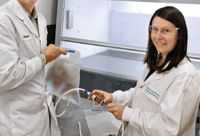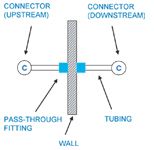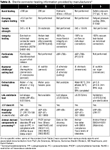A Review of Sterile Connectors
Many factors must be considered when choosing a sterile connector for a given process.
Abstract
There are now five sterile connectors that have been widely used in bioprocessing. They are designed to make processing easier and reduce potential for products to become contaminated. So how does a biopharmaceutical manufacturer select one over the other? A few of them have been on the market now for several years. However, others are starting to penetrate the market and they come with various advantages to suit particular applications. This paper summarizes a typical review of features and testing available for selection, along with items to consider for best design and performance, particularly for a single-use system.
A critical step, and risk, in the application of single-use components, is their final connection to form a usable assembly. Sterile connection is the critical "communication," or bridge, by which all the other pieces are made truly functional. Sterile connectors allow two lines of tubing to be joined while maintaining a sterile fluid pathway. Each line of tubing is pre-affixed to a connector end that has a removable membrane or valve barrier for mating to another connector end. Thus, the process line is maintained as closed and sterile even before a connection is made. Sterile connectors are designed to connect one processing stream to another, such as a container to a sampling line, media to a product vessel, or a filtration assembly to a filling line. They become beneficial when no biocontainment hood is available to make an aseptic connection or when operators are pressed for time.

Sanofi Pasteur
The line at the junction of the connection cannot be disconnected without force because of safety mechanisms in place to prevent this. If a disconnection is needed, one is best made using a disconnection device, tube sealer, or tube crimper. Theoretically, these single-use components can be used in a noncontrolled area and still maintain a sterile system.
On the Market
Sterile connectors currently on the market include the Kleenpak Sterile Connector (KPC) by Pall Life Sciences, Lynx S2S by Millipore, Opta SFT-1 by Sartorius Stedim Biotech, ReadyMate DAC by GE, and the Pure-Fit SC by Saint Gobain (Figure 1).

Figure 1. Sterile connectors (left to right): Kleenpak KPC by Pall, Lynx S2S by Millipore, Opta SFT-1 by Sartorius Stedim Biotech, ReadyMate DAC by GE, and the Pure-Fit SC by Saint-Gobain.
There are other types of similar devices that provide slightly different outcomes or are used for different purposes. Though not discussed in this paper, they include, steam-through connectors, non-sterile connectors (quick-connects), and tube welders.
Narrowing Connector Selection
First, one needs to be familiar with the application to identify where and how to introduce these sterile devices. Is a wet or dry connection required? What size of tubing is needed? Is product visibility through the connectors important? What are the operation and storage requirements? What is the maximum operating pressure? These easily rule out some of the options.
More specifically, ease of use weighs heavily over other aspects, because when we compared them, we found that a few of the connectors required brute strength to operate. Fortunately, some of these connection manufacturers are aware of this problem and are currently addressing it. The number of connection steps (including cap removal) and timing of each connection should be optimal for one's process and operators. For two of the available devices, the addition of an assembly aid to facilitate alignment or a clamp to secure the connection adds to procedural complexity.
Table 1 summarizes these and other factors to consider in the initial evaluation process; however, the names of each brand have been coded to avoid bias. Because some of the findings are qualitative, a thorough assessment should be done by each user.

Table 1. Initial product aspects for comparison of sterile connectorsâ
The geometry of the device is another criterion to consider. Some manifolds require several connectors in an assembly to attach a number of containers or lines. A longer connection adds length to the overall process; this can be problematic when the lines are longer than the working area or available space for equipment integration. Outer diameter and weight of these items also play a role. Product footprint and general bulkiness must be taken into account when transporting, assembling, and, if required, when passing devices through a wall or isolator fitting (Figure 2).

Figure 2. Spatial considerations. Cleanroom or isolator wall pass-throughs or fittings may require a sterile connector assembly to be drawn through partially.
Fortunately, there are technologies that now exist to address the latter. Flow restrictions, based on the inner geometry of the connector and the connected tubing, can affect the processing system, especially with respect to fluid velocity, fluid type (i.e., suspension, culture), and viscosity. In some cases, it may be desirable to step up or down a connection size, and, fortunately, the manufacturers have ensured the connector ends can be mated for this very purpose (i.e., a ¼" female can be connected to a ½" male). Other considerations in selecting a device are the stage of manufacturing and duration that the product will sit in the transfer lines, because those factors can affect the degree to which product contact materials affect product and vice versa. Manufacturers' claims of shelf-life should be reviewed carefully because it is not always clear whether the expiration date is based on real-time aging, accelerated aging, pre- or post-sterilization, or a combination of these. It also should be noted that some manufacturers have ongoing aging studies to extend their current shelf-life claim.
Assembly Considerations
A single-use assembly provider should be flexible when working on a client's design that includes sterile connectors. Tubing types, methods of securing tubing onto connectors (i.e., cable ties, barblocks), and willingness to use customer-specified components (i.e., those of their competitors) are aspects that should be considered when customers are selecting suppliers. Other factors to consider are sterilization options, gender-specific assemblies, and pricing.
Typically, two options are available for sterile connectors. The manufacturer may provide the connector on an assembly that has been presterilized by gamma irradiation. Alternately, connectors may be autoclaved along with assemblies made in-house. In addition, covering caps or packaging around the connectors may or may not be required for sterilization purposes. Finally, some of these devices cannot be autoclaved after irradiation. Suppliers must be able to demonstrate that all the materials of the connectors, both product contact and nonproduct contact, are compatible with sterilization.
All but one of the connection devices are gender-specific. When ordering a manifold, advanced planning of these assembly designs ensures that the correct gender-specific ends are present to connect with the mating end. This can be challenging when a manifold design is in early-stage manufacturing and changes may be made in the future. Adding extra connector ends to manifolds as a backup for sampling or transfer lines also can be a good precautionary step to take. However, this should not be necessary for finalized process designs. Genderless connectors consume less storage space in inventory because stocking does not require accounting for two different connector ends.
Price is an essential aspect of the evaluation, especially if the processes require a number of connectors or if there is a high turnover of batch manufacturing. In cases where, for example, thousands are used annually, an annual cost comparison with other alternatives may need to be done.
Testing Needs and Documentation Expectations
The sterile connector manufacturers provide data on the extensive testing they perform as part of their validation package and lot release program. Although many of these tests are performed in different ways, they ultimately end up with similar outcomes. Much can be said about each of these individual tests, however, end users should review these data thoroughly to ensure that the sterile connector has been challenged using worst-case conditions for proper selection and to mitigate risk. A compilation of most of the common tests manufacturers perform or data they will provide is shown in Table 2. For some types of studies, attention must be paid to whether testing is done after gamma irradiation, autoclaving, aging, or no sterilization.

Table 2. Sterile connector testing information provided by manufacturersâ
Burst testing confirms a maximum pressure that a connection can withstand. For the creeping and tensile testing, some of the suppliers claim these types of tests are only for plastics expected to undergo stretching, and others only perform these tests on the junction where the tubing meets the barbed or triclamped ending of the connector or where an adaptor is adhered to the connector end.
Regarding integrity testing, each manufacturer takes a slightly different approach. Testing includes dye leak, vacuum leak, air integrity, and helium leak testing. Some integrity tests are conducted according to standards (i.e., ASTM), whereas others use specialized manufacturing release integrity testers. Some of the manufacturers perform the test to confirm the integrity of each individual connector (i.e., male or female); others do this on the assembled connection. Some observations are performed by visible detection of leaks, yet others measure pressure change or helium detection. Technically, the most rigorous testing is the helium test, performed during both assembly and operation.
Particulates
The particulates test is done on a solution of water for injection after passing it through the connection. This can be done according to the pharmacopoeias. Alternatively, as in the case of the "particulate cleanliness test," for example, this testing also includes fibers and a broader range of particle sizes.
Bacterial Challenge
The bacterial challenge test typically is done by exposing the connector mating surfaces to a bacterial solution (by direct soiling or by aerosol) with a minimum colony forming unit (CFU) concentration, assembling the connection, passing sterile media through the connection, and collecting it. After incubation of the collected sample, absence of microbial growth confirms prevention of ingress of a contaminant. Proper controls must be demonstrated.
Extractables
Model solvent extractables are supplied by most of the connector manufacturers. Those devices composed primarily of polycarbonate are now also checked for bisphenol A (BPA) residuals because this substance, which can mimic estrogenic actions, is found in polycarbonates.1
LAL Endotoxin
The limulus amebocyte lysate (LAL) test has been completed by all but one of the suppliers, either as part of the validation or on every lot. The fifth manufacturer claims to be completing the test shortly.
Material Compliance
All of the manufacturers state that their connectors are composed of Class VI plastics and that they perform the USP biological reactivity testing in vivo. Some have completed the ISO in vitro or USP MEM cytotoxic elution testing as well.
For animal-free claims, all show compliance with regulatory bodies (i.e., EMEA, EC, or US CFR), especially because the plastics or plastics processing methods can contain trace levels of stearates, which typically are derived from bovine tallow. Tallow derivatives are not considered prohibited cattle materials according to the current revision of Title 21, of the US Code of Federal Regulations, part 189.5.2 Furthermore, an EMEA note for guidance (EMEA 410/01) has given specific consideration to tallow derivatives and it states that they are unlikely to be infectious because of the rigorous processing steps used.3
Training
Training in the use of these consumables is highly recommended to ensure they provide an integral connection. Implementing these products involves a number of steps and some require careful attention to avoid such mishaps as over- or under-actuation, misalignment, displacement of o-rings, and interference with membranes (i.e., peeling them off inappropriately). Many of the connectors have built-in safety features to avoid some of these potential troubles.
To ensure a good training program and good operation we recommend the following steps:
- Have vendor onsite demonstrations to show functionality and review the key features and operation.
- Train against well-written internal work instructions or operating procedures.
- Practice with complete assemblies and connections to other parts of the system.
- As required, include training on use of aids or clamps.
- Count clicks throughout the connection steps (if applicable).
- Review any visible differences after certain methods of sterilization (i.e., expected color changes).
If assembling the manifolds in house and autoclaving them, one must review with the manufacturer which securing aids are most appropriate to affix to the connectors in addition to autoclave wrapping scenarios.
Additional Testing
Vendor validation data are the most valuable references when it comes to having a complete testing and evaluation package. For incorporation into GMP manufacturing, most end-users will do a process media simulation (also know as a broth validation), whereby sterile broth is run through the processing lines including the sterile connectors.
Some end-users may do additional testing as part of their validation studies, dependent on specific product considerations. This may include a confirmatory integrity evaluation using pressurized gas and monitoring to detect leaks, a leachables study after a representative product solution is run and held through the devices, or a confirmatory bacterial challenge test. However, it is hoped that, in most cases, vendor-provided data obtained from testing under controlled or worst-case conditions will relieve the end-user from these additional burdens.
Finally, there are times when a user needs to ship a biopharmaceutical product from one location to another in a container with a sterile connector end on it. A shipping qualification may be performed to verify that a sterile connection can still be made after shipment because of packaging configuration, temperature, vibrations, handling, or bumping. There are many ways to go about this, including testing for contamination of a sterile broth-filled system, leak testing, or using more sophisticated packaging testing equipment to simulate or check for damages.
Performance Testing
Performance testing will verify function after expected or exaggerated conditions. Some examples include:
- post-sterilization—post autoclaving or gamma irradiation
- repeatability—testing several connections in the same condition to determine a statistically relevant failure rate
- various temperatures—after or during low or high operating or after low or high storage temperatures
- worst-case solutions—after transferring and holding various worst-case solutions
- disinfection—after applying outer components with a cleanroom disinfectant
- worst-case flow rates—during use with process-specific pumping mechanisms
- worst-case pressure—during application of fatigue and pressure cycling or safety pressure testing.
Many of these conditions can be combined into one test but this should be verified with the manufacturer to confirm suitability with their connectors and assemblies.
Conclusion
Sterile connectors make operation easier and faster than other methods of connections in an aseptic environment, such as open manipulations and tube welding, while completing the path of a sterile closed system. Nonetheless, due diligence is required to ensure that an appropriate connector type is selected and tested to satisfy the user, product requirements, system integrity, and safety.
Kirsten A. Strahlendorf is a process development scientist and Kevin Harper is a platform director, both at Sanofi Pasteur, Toronto, Canada, 416.667.2700, kirsten.strahlendorf@sanofipasteur.com
REFERENCES
1. Steinmetz R, Brown NG, Allen DL, Bigsby RM, Ben-Jonathan N. The environmental estrogen bisphenol A stimulates prolactin Release in vitro and in vivo. Endocrinol. 1997;138(5)1780–6.
2. Current revision of Code of Federal Regulations, Title 21: Food and Drugs, PART 189—Substances Prohibited from Use in Human Food, § 189.5 Prohibited cattle materials.
3.Note for guidance on minimizing the risk of transmitting animal spongiform encephalopathy agents via human and veterinary medicinal products (EMEA 410/01 Rev. 2 – Oct 2003) adopted by the Committee for Proprietary Medicinal Products (CPMP) and by the Committee for Veterinary Medicinal products (CVMP) Official J EU C 24, 28.1.2004, p. 6.
